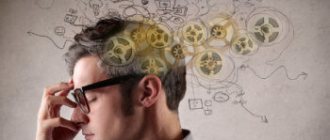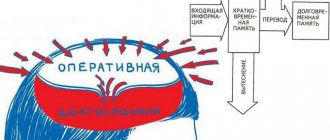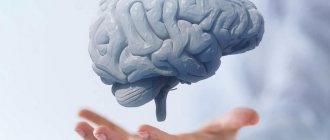Short-term memory is a special type of storing information. It includes operations that occur from the initial stage of memorization to the recording of traces of external influence. Subjectively, short-term memory can be considered as a reflection of an event that just happened - for another moment a person continues to see and hear what is no longer happening in real time. Short-term memory processes are unstable and reversible, last about 20 seconds, then disappear.
What is short-term memory
Short-term memory is the ability to retain information for a short period of time (20 to 30 seconds). The fading of the exact image begins already at 15-18 seconds, and by 30 it is already completely forgotten.
Forgetting in such a short period of time occurs when the goal is not to retain information for a long time. If a person intends to remember something, he transfers the received information to the level of long-term memory.
Short-term memory allows you to store information obtained from practical experience and used to perform habitual routine actions. So, a person can repeat a new phone number for some time and list the actions just performed.
Short-term memories play a very important role. If a person does not remember the actions he has just performed, he repeats them over and over again. The most striking example of short-term memory impairment is forgetting in Alzheimer's disease.
Short-term memory is a whole complex of cognitive abilities that can be trained. Main characteristics of this type of memory:
- Volume - for an adult, the minimum volume is 7 (+/-2) elements. The ability to hold more than 7 elements is a favorable sign. If a person retains less than 5 elements, this is regarded as a violation - diagnosis and work to eliminate (if possible) the problem, treatment is required.
- Filtering is the ability to discard information that is not valuable and retain important information. For example, in order to remember well the lecture material presented by the teacher, the student is not distracted by extraneous stimuli - the color of classmates’ clothes, noise from behind the door.
- The ability to transition to long-term memory - the accuracy of long-term memory directly depends on the volume of short-term memory.
Poorly encoded and stored short-term memory information passes into long-term memory in a distorted form, and the carrier (person) himself is not aware of this. This explains the fact that participants in the same events often describe them differently and consider their own account to be true.
If intelligence is connected to short-term memory, then the content of information becomes more important. For example, reinforcing information with visual stimuli (photos, paintings, tables, diagrams) allows you to remember it better, make it more structured, and reproduce it after some time.
Characteristics of sensory memory
We can highlight some characteristic features of the sensory type of memory:
— Short storage time for information (then it either goes into another form of storage or is irretrievably lost).
— The presence of modal varieties (for example, iconic (visual) and echoic (auditory) memory).
— Each subsequent signal displaces the previous one arriving at this sensor-analyzer.
— Resistance of received information to any influence (it cannot be delayed, made clearer, or reproduced).
— Preservation of information in its original form, with high accuracy of memorization.
- Large volume (after all, sensory memory is based on the work of a large number of sensory inputs for information, and the sense organs are affected by a large number of stimuli).
Thanks to the plasticity of the brain, we can develop perception, attention, memory and other cognitive functions. And by training them, we thereby contribute to the development of the brain and the creation of new neural connections
Perception, memory, attention, thinking are developed through regular training. For this purpose, you can successfully use online brain simulators.
Regular training allows you to achieve tangible results, as evidenced not only by gradually improving indicators, but also by examples from everyday life. You can read about it here: You can tell your story, share your impressions and achievements after several weeks of regular classes.
We sincerely wish you new victories and success in self-development!
Photo: Neuroscience News
Types of short-term memory
Short-term memory is divided into several types, based on how it is encoded.
Sound (auditory)
Information comes through the organ of hearing. For it to register, it is not enough just to hear. It is important to speak the information out loud or repeat it silently. Otherwise, the received information will disappear after 30 seconds.
Visual (visual)
Information comes through the organ of vision. To transfer a picture from the level of short-term memory to long-term memory, it is necessary to carry out phonological coding - say several times what a person sees (out loud or silently), select associations for what he saw.
Kinesthetic (tactile)
The process of memorization through tactile sensations. This type of memory does not actively work in all people. Kinesthetic learners must touch a thing, hold it in their hands, feel its warmth or cold, surface texture, weight in order to assimilate and consolidate information about it.
People with well-developed auditory memory easily reproduce heard information. To integrate new information into memory, visual learners must see it in the form of drawings, diagrams, notes. Practical work and experiments help kinesthetic learners remember information.
Types of human memory by sense organs
Figurative
This memory is responsible for remembering sights, smells, tastes and sounds. It is not difficult to guess which sense organs are developed in artists, sommeliers, chefs and musicians. However, figurative memory is quite easy to develop because we always have training tools at hand.
Verbal-logical
This is remembering and reproducing our thoughts. We also remember the content of a film, a conversation, a song.
Memory is not simply called verbal-logical. This type of memory manifests itself in three cases:
- Only the meaning of the information is remembered.
- Not only the meaning of information is remembered, but also the literal verbal expression of thoughts.
- The literal verbal expression of thoughts is remembered, but not the meaning.
Surely it has happened to everyone when we memorized a text word for word, but could not retell it in our own words. Or they didn’t remember the text, but could reproduce the essence.
Motor
This memory plays a key role for athletes and people who, as part of their profession, must remember a certain sequence of movements. For example, actors not only learn to get used to the role in order to look truthful on stage, but also sign up for dances - the more developed the motor memory, the easier it is to improvise and perform non-standard movements.
Emotional
This memory is associated with experiences, both positive and negative. With its help, both phobias and the level of happiness are formed. The higher the emotional intensity, the better a person will remember the experience. This memory is often used to learn foreign words, trying to emotionally “attach” one’s experiences to the word being studied.
Stages
When a person is not faced with the task of remembering information, short-term memory works. The trace of an event or information disappears within 30-40 seconds. In a situation where there is a need to retain information for a longer period, memorization occurs in 3 stages.
Stage 1 - coding
To retain an image within short-term memory, you need to concentrate your attention on it - notice the most important thing, and ignore everything that is unimportant. Irrelevant information will be forgotten after 30 seconds.
For example, if you need to remember the amount spent on purchases, then after some time a person can easily reproduce the exact number. But he is unable to remember the name of the cashier, how many people stood in line in front of him - this unimportant information was supplanted almost immediately.
In people, information encoding in the structure of short-term memory occurs in different ways, using auditory, kinesthetic or visual types of perception.
- with acoustic encoding, in order to remember information, it is necessary to repeat it loudly or silently;
- visual encoding involves creating a powerful association with what you see. This type of coding is the main one in people with photographic memory;
- kinesthetic - memorization occurs through tactile sensations.
Short-term memory consists of two components - buffers (storage). Different brain structures are responsible for each of them. The first buffer (located in the left hemisphere of the brain) stores information received through the auditory organ. The second buffer (in the right hemisphere) is responsible for storing information received through the organ of vision
Stage 2 - storage
Long-term memory stores pictures from the past - childhood, school years, vivid events that happened not so long ago. Sometimes it seems that the memory store has no boundaries; you can find any memories in it. The situation is different for short-term memory. Its volume is minimal.
American psychologist George Miller defined a formula (7+/-2) that most accurately reflects the ability of the average adult to retain information. Short-term memory lasts no longer than 30-40 seconds. But due to various reasons, the duration and number of elements held may fluctuate in both directions.
The short-term memory formula is easy to check yourself. To do this, you need to quickly look through a small list (movies, names, products), turn around and try to reproduce it, and then count the number of items.
Retention of information by short-term memory occurs through consolidation and forgetting. Those who want to increase their ability to retain information need to understand what these two processes are.
Enlargement example
The task was set - to reproduce letters in a given sequence - Sruoyylerecnis - in a short period of time. For a person who has not previously studied English, it will be easy to repeat 5-7 letters. Anyone who speaks English will be able to retrieve the previously memorized phrase Sincerely Yours from long-term memory. As a result, he enlarges a given combination of 14 letters into two words that are very easy to remember.
The method of enlarging and retrieving associations from memory makes it possible to reduce the amount of information that needs to be stored.
Forgetting
Short-term memories are very quickly erased from memory due to fading and replacement by new ones. Extinction is due to the fact that attention is not focused on the information received. Even if a person immediately encoded it (said it out loud), then as soon as he told it to someone else or wrote it down on paper, the information disappears from memory, as if it had lost its relevance.
The image is erased for another reason. If you have to remember new information every day, then it is “overlaid” by more recent information. For example, it is quite easy to recite the amount spent in a store today and yesterday, but it is not easy to reproduce the amount on a receipt from two weeks ago.
Stage 3 - Reproduction
It seems that the process of reproducing newly received information is easier than restoring what was previously received. The reason for this illusion is the belief that in order to reproduce previously received information, you need to find it in storage, and only then release it, and in short-term memory the image “lies on the surface.”
But the more elements are contained in the repositories, the slower and less accurate the information is reproduced. Thus, a telephone number of 10 digits is extremely difficult to repeat without making at least one mistake. If the number contains only 6-7 digits, the probability of accurate reproduction is much higher (Miller's formula).
When training short-term memory, this must be taken into account. It is important not to try to memorize a large number of elements (words, numbers) at a time, but to gradually increase their volume.
Classification by purpose
Depending on the role this memorization process plays in interaction with the outside world and how it helps to accumulate information about various objects that is useful for the individual, it is classified as one of the subtypes of the memory system.
Declarative (explicit) memory
It is also characterized as an expanded type of memory - these are conscious memories that were previously specifically analyzed, organized and stored for further use. Each person, consciously remembering certain events or lessons, uses this type of memory. This is a large system that includes more specialized units.
Episodic
As the name itself makes clear, these memories reproduce individual episodes from the life of the person himself or events that took place in his immediate vicinity. At the same time, the detail of such passages is maximum and allows you to analyze what happened after its completion. This process is comparable to short video files that carry only a set of information about an event without conclusions or analysis. memory can be improved by training not only the visual sensory system, but also all others directly involved in creating a realistic and complete image of an event.
Semantic
It is a comprehensive set of knowledge about the world around us. It is fundamentally different from episodic and does not have such detail. The source of knowledge can be various cases with the object itself or information from other people that forms clear theses about certain objects or events. Such data is stored longer than clear episodes from life and a person can use it at any point in his life. Includes not only facts, but also concepts or the meaning of certain things. Takes direct part in understanding the world around us, starting from birth.
Autobiographical
A specific type of explicit memory, which contains the previous two, but concerns only autobiographical experience. That is, with the help of these processes, a person perceives himself as a person, has knowledge about himself, his character, actions, achievements, capabilities, etc., but at the same time, he remembers specific episodes from his life. It carries important functions for the existence and interaction of a particular person.
Social functions (intersubjective):
- Empathy for another person (empathy)
- Anticipating other people's actions based on one's own experience
- Building relationships with other people
- Opportunity to share your own experience
- Development of social tolerance or rejection
Awareness of one's uniqueness (existential):
- Understanding your own uniqueness as an individual
- Identifying oneself as a member of a particular culture
- Defining yourself as an individual
- Concept of meaning
- Opportunity to know yourself
- Dividing life into certain periods
- Identity is the ability to briefly express one’s belonging according to various parameters (culture, religion, nationality, politics, language, economic status)
Internal self-regulation (intrasubjective):
- Finding your life's path
- Formation of ideas about oneself
- Self-management of your mental state
Procedural (implicit) memory
This is an unconscious system for collecting, updating and storing information. Unlike conscious memory, in this type of memory, data is stored in the form of indescribable images that can simply be demonstrated with an example. This information is collected on the basis of the individual’s experience and helps him in the future when solving similar problems. It also includes memory for movements, which are then reproduced unconsciously.
Short-term memory: possible problems and disorders
Problems with short-term memory can be caused by pathological conditions in which the information received is not retained. Short-term memory disorders are very common, they occur in every 4 inhabitants of the planet.
In most cases, problems arise in older people; their memory impairment is permanent or episodic. Impaired ability of young people to retain received information interferes with learning and does not allow them to concentrate on work.
People with short-term memory impairments remember events of the past well (what happened several years, decades ago), but are not able to answer the question of what just happened.
Problems with short-term memory can be caused by the following conditions:
- depression - when the balance of hormones and neurotransmitters in the brain is disrupted, the ability to concentrate is lost because of this;
- ischemic stroke - against its background, the blood supply to the brain is disrupted, oxygen starvation of the organ occurs;
- psychological trauma - the psyche prevents the preservation of painful information, displaces it into the unconscious. Associated with this reaction is the phenomenon when a person in a state of passion cannot remember what happened within a few minutes;
- traumatic brain injuries impair short-term memory;
- bad habits (smoking, drinking alcohol, drugs) improve the supply of oxygen to the brain.
Problems with short-term memory arise against the background of the appearance of tumors in the brain, as well as in Alzheimer's disease and schizophrenia. The reason for forgetting the events that just happened may be severe physical exhaustion, lack of sleep, severe infectious processes (HIV, tuberculosis, syphilis).
A violation can be suspected by the lack of logic during reasoning, confusion of thoughts and consciousness, and fragmentary memories. A person with a problem has deteriorating vision - spots flicker before the eyes, blurry pictures appear. Other symptoms of the anomaly also occur:
- depressed state, increased anxiety;
- thinking and cognitive abilities, the process of perception, and mastery of skills deteriorate;
- Muscle spasms occur and coordination of movements is impaired.
Deterioration of short-term memory affects the quality of life, greatly reducing it. At the first difficulty with remembering, it is necessary to be examined and, if necessary, undergo treatment.
Diagnosis of decreased short-term memory ability involves:
- determining the volume and duration of storage of received information;
- study of the basic processes of memory - memorization, storage, reproduction.
To diagnose each of the components of short-term memory, use:
- Hinrichs guessing method (for duration research);
- Jacobs, Sperling, Vuchetich/Zinchenko tests;
- Luria/Leontiev test of Vysotsky pictograms (memorization process);
- Ebbinghaus method (conservation);
- the process of information reproduction is studied using the methods of a given standard, reconstruction, saving, and sequential reproduction.
Each of the diagnostic methods used carries out a valeological assessment of short-term memory, taking into account physiological factors. The diagnostician takes into account age, gender, health status at the time of the study and the presence of chronic pathologies. To obtain the most reliable results, testing is repeated several times.
In some cases, neuropsychological diagnosis may not be sufficient. If organic brain damage is suspected, in which short-term memory is impaired, doctors recommend undergoing neurosonography, MRI of the brain, and electroencephalogram.
Types of memory and their features (Nemov R. S.)
Classification of types of memory according to the senses and the use of mnemonic means: figurative, verbal-logical, motor, emotional, voluntary and involuntary, mechanical and logical, direct and indirect.
Features of short-term memory, its volume, mechanisms, connection with consciousness. The phenomenon of substitution is the replacement of information in short-term memory that is overcrowded. Difficulties in mechanical memorization of names and surnames and the phenomenon of substitution. Acoustic recoding of information in short-term memory. The connection between short-term memory and long-term memory, their relative independence. The subconscious nature of human long-term memory. The connection between long-term memory and speech and thinking, in particular with inner speech. Semantic organization of material in long-term memory. There are several bases for classifying the types of human memory. One of them is the division of memory according to the time of storage of the material, the other - according to the analyzer that predominates in the processes of memorizing, storing and reproducing the material. In the first case, instantaneous, short-term, operational, long-term and genetic memory are distinguished. In the second case, they talk about motor, visual, auditory, olfactory, tactile, emotional and other types of memory. Let us consider and give a brief definition of the main types of memory mentioned above.
Instant,
or
iconic,
memory is associated with retaining an accurate and complete picture of what has just been perceived by the senses, without any processing of the information received. This memory is a direct reflection of information by the senses. Its duration is from 0.1 to 0.5 s. Instantaneous memory is the complete residual impression that arises from the immediate perception of stimuli. This is a memory-image.
Short term
memory is a way of storing information for a short period of time. The duration of retention of mnemonic traces here does not exceed several tens of seconds, on average about 20 (without repetition). In short-term memory, not a complete, but only a generalized image of what is perceived, its most essential elements, is stored. This memory works without a preliminary conscious intention to memorize, but with an intention to subsequently reproduce the material. Short-term memory is characterized by such an indicator as volume. It is on average equal to 5 to 9 units of information and is determined by the number of units of information that a person is able to accurately reproduce several tens of seconds after this information has been presented to him once.
Short-term memory is associated with the so-called actual human consciousness. From instant memory, it receives only that information that is recognized, correlates with the current interests and needs of a person, and attracts his increased attention.
Operational
called memory designed to store information for a certain, predetermined period, ranging from several seconds to several days. The storage period of information in this memory is determined by the task faced by a person, and is designed only for solving this problem. After this, information may disappear from RAM. This type of memory, in terms of the duration of information storage and its properties, occupies an intermediate position between short-term and long-term.
Long-term
is
a memory that can store information for an almost unlimited period of time. Information that has entered the storage of long-term memory can be reproduced by a person as many times as necessary without loss. Moreover, repeated and systematic reproduction of this information only strengthens its traces in long-term memory. The latter presupposes a person’s ability, at any necessary moment, to recall what was once remembered by him. When using long-term memory, remembering often requires thinking and willpower, so its functioning in practice is usually associated with these two processes.
Genetic memory
can be defined as one in which information is stored in the genotype, transmitted and reproduced by inheritance. The main biological mechanism for storing information in such memory is, apparently, mutations and associated changes in gene structures. Human genetic memory is the only one that we cannot influence through training and education.
Visual memory
associated with the preservation and reproduction of visual images. It is extremely important for people of any profession, especially for engineers and artists. Good visual memory is often possessed by people with eidetic perception, who are able to “see” the perceived picture in their imagination for quite a long time after it has ceased to affect the senses. In this regard, this type of memory presupposes a person’s developed ability to imagine. In particular, the process of memorizing and reproducing material is based on it: what a person can visually imagine, he, as a rule, remembers and reproduces more easily.
Auditory memory
is
a good memory and accurate reproduction of a variety of sounds, such as music and speech. It is necessary for philologists, people studying foreign languages, acousticians, and musicians. A special type of speech memory is verbal-logical, which is closely related to word, thought and logic. This type of memory is characterized by the fact that a person who has it can quickly and accurately remember the meaning of events, the logic of reasoning or any evidence, the meaning of a text being read, etc. He can convey this meaning in his own words, and quite accurately. This type of memory is possessed by scientists, experienced lecturers, university teachers and school teachers.
Motor memory
represents the memorization and preservation, and, if necessary, reproduction with sufficient accuracy of a variety of complex movements. It participates in the formation of motor, in particular labor and sports, skills and abilities. Improving human manual movements is directly related to this type of memory.
Emotional memory
is
memory for experiences. It is involved in all types of memory, but is especially evident in human relationships. The strength of memorizing material is directly based on emotional memory: what causes emotional experiences in a person is remembered by him without much difficulty and for a longer period.
Tactile, olfactory, gustatory
and other types of memory do not play a special role in human life, and their capabilities are limited compared to visual, auditory, motor and emotional memory. Their role mainly comes down to satisfying biological needs or needs related to the safety and self-preservation of the body.
According to the nature of the participation of the will in the processes of memorizing and reproducing material, memory is divided into involuntary
and
arbitrary .
In the first case, we mean such memorization and reproduction that occurs automatically and without much effort on the part of the person, without setting a special mnemonic task for himself (for memorization, recognition, preservation or reproduction). In the second case, such a task is necessarily present, and the process of memorization or reproduction itself requires volitional efforts.
Involuntary memorization is not necessarily weaker than voluntary; in many cases in life it is superior to it. It has been established, for example, that it is better to involuntarily remember material that is the object of attention and consciousness, acts as a goal, and not a means of carrying out an activity. Involuntarily, one also remembers better material that involves interesting and complex mental work and that is of great importance to a person. It is shown that in the case when significant work is done with the memorized material to comprehend, transform, classify, and establish certain internal (structure) and external (associations) connections in it, it can be remembered involuntarily better than voluntarily. This is especially typical for children of preschool and primary school age.
Let us now consider some features and relationships between the two main types of memory that a person uses in everyday life: short-term and long-term.
Short-term memory capacity
individual.
It characterizes a person’s natural memory and shows a tendency to be preserved throughout life. It primarily determines mechanical memory and its capabilities. Associated with the characteristics of short-term memory, due to its limited capacity, is a property called substitution .
It manifests itself in the fact that when the individually limited volume of a person’s short-term memory becomes full, newly arriving information partially displaces the information stored there, and the latter irretrievably disappears, is forgotten, and does not end up in long-term storage. This, in particular, happens when a person has to deal with information that he is not able to fully remember and which is presented to him continuously and sequentially.
Why, for example, do we so often experience serious difficulties in remembering and retaining in memory the names, surnames and patronymics of people new to us, with whom we have just been introduced? Apparently, for the reason that the amount of information available in these words is at the limit of the capabilities of short-term memory, and if new information is added to it (and this is exactly what happens when the person presented to us begins to speak), then the old, associated with his name is repressed. By involuntarily switching our attention to what a person is saying, we thereby stop repeating his name, surname and patronymic and, as a result, soon forget about them.
Short-term memory plays a big role in human life. Thanks to it, the largest amount of information is processed, unnecessary information is immediately eliminated and potentially useful remains. As a result, there is no information overload of long-term memory with unnecessary information, and a person’s time is saved. Short-term memory is of great importance for organizing thinking; The material of the latter, as a rule, is facts located either in short-term memory or in operative memory close in its characteristics to it.
This type of memory also actively works in the process of person-to-person communication. It has been established that when people meeting for the first time are asked to talk about their impressions of each other, to describe the individual characteristics that they noticed in each other during the first meeting, on average they usually name the number of traits that corresponds to the capacity of short-term memory , i.e. 7+2.
Without good short-term memory, normal functioning of long-term memory is impossible. Only what was once in short-term memory can penetrate into the latter and be deposited for a long time. In other words, short-term memory acts as a mandatory intermediate storage and filter that passes the necessary, already selected information into long-term memory.
The transition of information from short-term to long-term memory is associated with a number of features. The last 5 or 6 units of information received through the senses enter short-term memory, and they penetrate first into long-term memory. By making a conscious effort to repeat the material, you can retain it in short-term memory for longer than a few tens of seconds. Thus, it is possible to ensure the transfer from short-term to long-term memory of such an amount of information that exceeds the individual capacity of short-term memory. This mechanism underlies memorization through repetition.
Usually, without repetition, only what is in the sphere of a person’s attention ends up in long-term memory. This feature of short-term memory is illustrated by the following experiment. In it, subjects are asked to remember only 3 letters and reproduce them after about 18 seconds. But in the interval between the initial perception of these letters and their recall, the subjects are not given the opportunity to repeat these letters to themselves. Immediately after presenting three different letters, they are asked to quickly begin counting backwards in threes, starting with some large number, for example, 55. In this case, it turns out that many subjects are not able to remember these letters at all and reproduce them accurately through 18 p. On average, no more than 20% of the information they originally perceived is retained in the memory of people who have gone through a similar experience.
Many of life's psychological problems that seem to be related to memory actually depend not on memory as such, but on the ability to ensure long-term and sustained attention of a person to the memorized or recalled material. If you can draw a person’s attention to something, focus his attention on it, then the corresponding material is better remembered and, therefore, retained in memory longer. This fact can be illustrated by the following experiment. If you invite a person to close his eyes and unexpectedly answer, for example, the question about what color, shape and what other features an object has that he has seen more than once, passed by repeatedly, but which did not attract increased attention, then the person with can hardly answer the question posed, despite the fact that he has seen this object many times. Many people make mistakes when they are asked to say which numeral, Roman or Arabic, represents the number 6 on the dial of their mechanical watch. It often turns out that it is not on the watch at all, and a person who has looked at his watch dozens or even hundreds of times does not paid attention to this fact and, therefore, did not remember it. The procedure for introducing information into short-term memory is the act of paying attention to it.
One of the possible mechanisms of short-term memory is temporal encoding,
those. reflection of memorized material in the form of certain, sequentially located symbols in the human auditory or visual system. For example, when we remember something that can be denoted by a word, we, as a rule, use this word, mentally pronouncing it to ourselves several times, and we do this either consciously, thoughtfully, or unconsciously, mechanically. If we need to visually remember a picture, then after looking at it carefully, we usually close our eyes or distract our attention from looking at it in order to focus it on memorizing. At the same time, we always try to mentally reproduce what we saw, imagine it visually, or express its meaning in words. Often, in order for something to be truly remembered, we try to evoke a certain reaction in ourselves by association with it. The generation of such a reaction should be considered as a special psychophysiological mechanism that promotes the activation and integration of processes that serve as a means of memorization and reproduction.
The fact that when information is entered into long-term memory, it is, as a rule, recoded into acoustic form, is proven by the following experiment. If subjects are visually presented with a significant number of words, which obviously exceed the capacity of short-term memory in number, and then analyze the errors that they make when reproducing it, it turns out that often the correct letters in words are replaced by those erroneous letters that are close to them in sound. and not by writing. This, obviously, is typical only for people who master verbal symbolism, i.e. sound speech. People who are congenitally deaf do not need to convert visible words into audible words.
In cases of painful disorders, long-term and short-term memory can exist and function relatively independently. For example, with such a painful memory disorder, which is called retrograde amnesia, mainly the memory of recently occurring events suffers, but memories of those events that took place in the distant past are usually preserved. In another type of disease also associated with memory impairment, anterograde amnesia, both short-term and long-term memory remain intact. However, the ability to enter new information into long-term memory suffers.
At the same time, both types of memory are interconnected and work as a single system. One of the concepts describing their joint, interconnected activities was developed by American scientists R. Atkinson and R. Shifrin. It is shown schematically in Fig. 42. In accordance with the theory of the named authors, long-term memory seems to be practically unlimited in volume, but has limited capabilities for voluntary recall of the information stored in it. In addition, in order for information from short-term storage to get into long-term storage, it is necessary that some work be done with it while it is in short-term memory. This is the work of recoding it, i.e. translation into a language understandable and accessible to the human brain. This process is somewhat similar to what occurs when entering information into an electronic computer. It is known that all modern computers are capable of storing information in binary codes, and in order for the machine’s memory to work, any information entered into it must be presented in this form.
In many life situations, the processes of short-term and long-term memory work in conjunction and in parallel. For example, when a person sets himself the task of remembering something that obviously exceeds the capabilities of his short-term memory, he often consciously or unconsciously turns to the use of semantic processing and grouping of material that facilitates memorization. Such grouping, in turn, involves the use of long-term memory, turning to past experience, extracting from it the knowledge and concepts necessary for generalization, ways of grouping the memorized material, reducing it to a number of semantic units that do not exceed the capacity of short-term memory.
Rice. 42. Memory scheme according to R. Atkinson and R. Shifrin. The interconnected work of short-term and long-term memory, including repression, repetition and encoding as private processes that make up the work of memory
Translating information from short-term to long-term memory often causes difficulties, since in order to do this best, it is necessary to first comprehend and structure the material in a certain way, to connect it with what a person knows well. It is precisely because of the insufficiency of this work or because of the inability to carry it out quickly and effectively that people’s memory seems weak, although in fact it may have great potential.
Let us now consider the features and some mechanisms of long-term memory.
This memory usually begins to function not immediately after a person has perceived and memorized the material, but after some time necessary for the person to internally be able to switch from one process to another, from memorization to reproduction. These two processes cannot occur in parallel, since their structure is different, and the mechanisms are incompatible and in opposite directions. Acoustic coding is characteristic of transferring information from short-term to long-term memory, where it is already stored, probably not in the form of sound, but in the form of semantic codes and structures associated with thinking. The reverse process involves translating thoughts into words.
If, for example, after a certain number of readings or listening, we try to reproduce a long series of words after some time, then we usually make mistakes as when short-term memory does not work when memorizing. However, these errors are different. In most cases, instead of forgotten words, when remembering, we use others that are close to them not in sound or spelling, but in meaning. It often happens that a person, being unable to accurately remember a forgotten word, at the same time remembers its meaning well, can convey it in other words and confidently rejects other combinations of sounds that are not similar to the given word. Because the meaning of what we remember comes to mind first, we can eventually remember what we want, or at least replace it with something that is close enough in meaning to it. If this were not the case, we would have great difficulty remembering and often fail. The process of recognizing something once seen or heard is probably based on this same feature of long-term memory.
Literature
Blonsky P.P.
Selected pedagogical and psychological essays.
— T. II. - M., 1979. (Memory and thinking: 118-341. Memory. Recall: 341-366.)
Vein A.M., Kamenetskaya B.I.
Human memory.
- M., 1973. (Types of memory: 99-113. Age-related changes in memory: 114-121.)
Zinchenko P.I.
Involuntary memorization.
- M., 1961. (The problem of involuntary and voluntary memorization in psychology: 9-137. Involuntary memorization and activity: 141-221. Involuntary memorization and motivation: 222-241. Comparison of involuntary and voluntary memorization: 245-425. Memory development: 425-514.)
Ippolitov F.V.
Schoolchild's memory.
- M., 1978. (Tips for improving memory: 28-45.)
Klatsky R.
Human memory.
Structures and processes. - M., 1978. (Short-term memory: 83-159. Long-term memory:
160-215. Memorization: 216-236. Recall (reproduction):
237-271. Memory and vision: 272-291.)
Leontyev A.N.
Selected psychological works:
In 2 volumes - M., 1983. - Volume I. (Development of higher forms of memorization:
31-64.)
Lyaudis V.Ya.
Memory in the process of development.
- M., 1976. (Development of memory: 8-37, 94-137. Voluntary memorization: 38-93. Relationship between short-term and long-term memory: 138-219. Development of memory in the learning process: 220-246.)
Mechanisms of memory. Guide to Physiology. - L., 1987. (Memory, its functions and connection with brain function: 7-20. Emotions and memory regulation: 325-351. Neuropsychological regulation of memory: 351-356. Psychophysiological aspects of memory modulation: 374-388.)
Nikolov N., Neshev G.
The mystery of millennia.
What do we know about memory? - M., 1988. (Memory mechanisms: 67-83.)
General psychology. - M., 1986. (Memory: 291-321.)
Cognitive activity in the system of memory processes. - M., 1989. (Activity approach to memory: 7-10. Relationship between cognitive activity and memory: 10-24. Relationship between voluntary and involuntary memorization: 25-43.)
Memory development. - Riga, 1991. (What is memory: 5-10. Paradoxes of memory: 11-117. Memory through the eyes of a physiologist: 18-30. Memory through the eyes of a psychologist: 31-42. Is it possible to train memory: 43-47. What kind of memory do I have? : 48-53.)
Development of creative activity of schoolchildren. - M., 1991. (Development of memory: 126-149.)
Smirnov A.A.
Selected psychological works: In 2 volumes - Vol. II.
- M., 1987. (Problems of the psychology of memory: 5-294. On some correlations in the field of memory: 316-327.)
––
Nemov R.S. Psychology : Textbook. for students higher ped. textbook establishments: In 3 books. — 4th ed. — M.: Humanite. ed. VLADOS center, 2003. - Book. 1: General fundamentals of psychology. — 688 p. pp. 219-228.
How short-term memory develops
You can improve your cognitive abilities and improve your short-term memory through regular exercise. Neurologists and neuropsychologists recommend:
- online brain trainers;
- method of repeated repetition (reproduce the same information at intervals of several hours or days);
- simplify (enlarge) the material so that it is easier to remember;
- use figurative and associative thinking;
- add an emotional component, making the information more vivid.
Intellectual games, memorizing poetry, and learning foreign languages are of great benefit.
| The principle of improving memory | Method to improve memory |
| interest | interesting things are easy to remember |
| comprehension | deeply understood information is remembered well |
| installation | if a person is determined to remember information, then it is well absorbed |
| action | information that can be applied in practice is absorbed very well |
| context | associative linking helps to remember information |
| braking | when learning new information, the old one “overlaps” |
| repetition | repetition helps to retain information well |
| optimal row length | the information to be learned should not be much longer than the capacity of short-term memory |
A person’s lifestyle also affects their ability to remember. Therefore, experts recommend:
- give up bad habits - smoking, alcoholism, drug addiction;
- sleep at least 7-8 hours a day;
- walk in the fresh air at least 1 hour a day;
- avoid stressful situations;
- alternate mental and physical activity;
- eat a balanced diet.
Neurologists prescribe a course of treatment with drugs to improve cerebral circulation in patients with incipient cognitive problems. If a tumor is present, surgery is considered. In most cases, an integrated approach makes it possible to restore short-term memory or slow down its decline.
Irina Sherbul
What diseases affect long-term and short-term memory?
Abnormal memory functioning is usually divided into:
- hypomnesia (conditions in which long-term and short-term types of memory are impaired);
- hypermnesia (pathological exacerbation of memory);
- paramnesia (reproduction of memories is highly distorted).
Hypomnesia is usually caused by:
- intoxication;
- TBI;
- vascular lesions of the brain.
The cause of hypermnesia, in most cases, is brain dysfunction associated with taking certain psychoactive compounds, paraphrenic syndrome, and progressive paralysis.
Paramnesia is a common symptom of exogenous mental disorders.
Classification of types of memory in psychology
Characteristics of other organisms, in addition to humans, include genetic and mechanical memory. The first of them is stored in the genotype of a living organism and is inherited. It is impossible to have any influence on it using the methods known to us. Rote memory is a learning ability based on repetition, without thought or awareness of actions.
Depending on which of the senses is most involved in the memorization process, the following types of memory are distinguished: auditory, visual and tactile. Based on the duration of information storage, it is divided into long-term and short-term.
Also, the classification of types of memory is made according to the type of human thinking. According to it, associative, logical, and indirect memory are distinguished.
The first type is the process of assimilation of information through the construction of a certain chain of associations. So, for example, when a person studies a foreign language, this or that word may seem similar in pronunciation to Russian. This will make it much easier to remember.
Logical memory is built on the semantic relationship of various elements that need to be remembered. Having understood the cause-and-effect relationships, a person can easily assimilate the information he needs.
Indirect memory is based on the comparison of new knowledge with a person’s existing life experience. It includes both logical and associative memory.
Depending on how purposefully a person assimilates information, psychology distinguishes such types of memory as voluntary and involuntary. In the first case, knowledge is recorded accidentally, automatically. Involuntary memory involves the purposeful concentration of a person’s attention to retain the necessary information.











